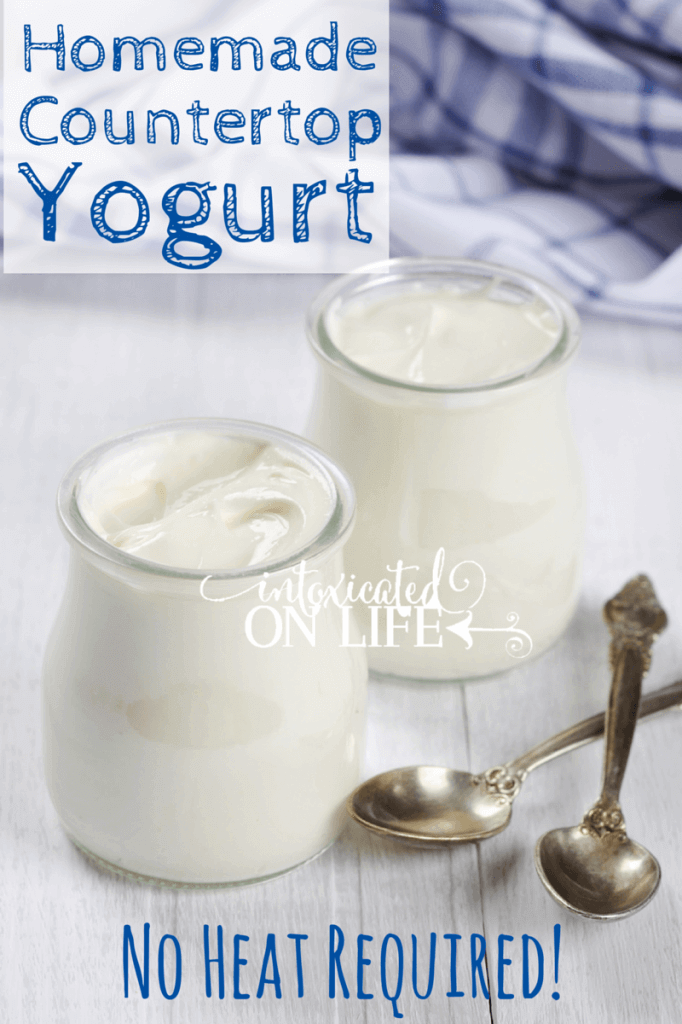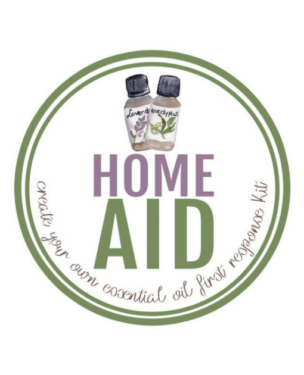I’ve got this Homemade Countertop Yogurt recipe to share with you today. No heat required!
That’s right, you can make yogurt without incubating it in the oven, crock-pot, or yogurt maker. Just set it on the counter and watch it go! It’s true.
For several years I’ve made yogurt using a fairly easy method. But it does require that I leave my oven on 100 degrees overnight. It’s not the worst thing in the world, but being able to make yogurt and not heat the oven is even better.
The Yogurt/Bacteria/Temperature Connection
What makes yogurt yogurt? Yogurt is made when you culture bacteria (good bacteria) in milk. Yes, there is such a thing as good bacteria. In fact, good bacteria is absolutely essential for good gut health. Don’t fear the bacteria!
Strange Fact: Did you know our bodies are made up of roughly 10 trillion cells, and at the same time we house an impressive 100 trillion bacterial cells. Bacteria are part of our microbiome. Crazy!
The types of bacteria that are present in our yogurt starter determine the taste, texture, consistency, and temperature at which our yogurt must be cultured.
Thermophilic vs. Mesophilic
Let’s talk a little bit more about two categories of yogurt: thermophilic and mesophilic.
Thermophilic; adj. requiring high temperatures for normal development.
Thermophilic bacteria requires prolonged heat in order to culture properly to make the transformation to yogurt. This type of bacteria grows best at high temperatures.
Mesophilic; adj. growing best at moderate temperatures.
Mesophilic bacteria is the type you use to make homemade countertop yogurt. This yogurt typically does best between 70-77 degrees Fahrenheit.
How to Make Homemade Countertop Yogurt
Now that we’ve completed our mini-science lesson let’s get down to the nitty-gritty. How do you make homemade countertop yogurt? Well, first you have to get your hands on the correct culture. I’d recommend purchasing your cultures from Cultures for Health. They have several varieties of mesophilic yogurt. The one I have tried and enjoy is their Villi yogurt.
One package contains 2 starter packets, but you only need to use one to get your yogurt going. After you make your first batch, just reserve a bit of plain yogurt to use as a starter for your next batch. You can continue doing this indefinitely. Cool, eh?
Homemade Counter Top Yogurt
Ingredients
- 1/2 gallon of milk
- 1 yogurt starter culture
Instructions
- Activate your yogurt starter according to the manufacturer's directions. This will activate your culture and give you starter yogurt.
- Place 8 Tablespoons of your cultured yogurt (from the activated starter) into a plastic container. Pour the milk over the yogurt.
- Mix thoroughly.
- Place a lid on the container.
- Set the container in a spot on your counter top that stays consistently between 70-77 degrees fahrenheit.
- Let the yogurt culture for 12-18 hours, or until the yogurt moves away from the wall of the bowl in one mass when tilted (it shouldn't run up the sides).
- Refrigerate your yogurt for at least 6 hours.
- Eat and enjoy!
Notes
Have you ever made homemade countertop yogurt before? Tell me about it in the comments below!
More Delicious Healthy Food Recipes:
- Grain-Free Granola with Coconut Milk “Yogurt”
- Spiced Apple Kombucha
- Nutritious Mint Chip Breakfast Smoothie
- 101 Grain-Free, Gluten-Free Snack Ideas for Kids
- Top 10 Healthy Ice Cream Treats (with Sugar-Free, Dairy-Free Options)












Can you do this using dairy alternatives, like rice, hemp or coconut milk?
I’ve never tried, but probably will be looking into it soon since I need to try going dairy free for a few months. According to the Cultures for Health site, their starters do work with non-dairy milks. I’d definitely check out the FAQ’s from whomever you purchase your starter from!
How does the texture and flavor of this compare to the kind of yogurt most of us are used to? I’ve been wanting to try this, but I can’t decide which starter to get!
(One of these days I’m going to figure out kefir, too! I know it’s supposed to be easy, but I don’t think mine has ever done what it’s supposed to. It’s always tasted more like “bad milk” to me than like “soured milk,” if that makes any sense, and I haven’t managed to figure out what I’m doing wrong.
Yes, kefir is super easy to make. But remember, you CANNOT use the organic milk you get at the typical grocery store as it is ULTRA PASTEURIZED and will no turn into kefir.
Make sure you keep your grains to no more a tablespoon or rounded tablespoon per quart. Remove extra grains (they keep multiplying) and store in milk in your refrigerator.
When you first start kefir, it can take up to 2 days to set. After a batch or two (unless your kitchen is really chilly), it will take 24 hours. It should be thick & creamy.
My favorite kefir is made from raw organic milk. If you cannot get raw milk, you need to find a source of lightly pasteurized milk.
I use the milk from the store and it works great for me to make Kefir. A little trick for thicker Kefir is let it sit on the counter for a day, then let it sit in the fridge for a few more, then put a lid on and shake then strain thru a mesh strainer. Add a little back to the grains and repeat. So good and much easier than yogurt which I haven’t gotten just right yet either. I live in WI and raw milk is not available unless you want a fine or jail time.
How do I start from yogurt?
Hi Molly,
You really have to start with a starter first to make sure you have the right type of bacteria that will grow at room temp. After that, you will be able to use the yogurt you made to make new batches of yogurt.
Can you freeze your new batch of yogurt?
Yogurt doesn’t really freeze well (most dairy doesn’t) so I wouldn’t recommend it. But you could try it and see what happens.
One more thing…😊. I went to Culture for Health and could not find the Villi starter ☹️
It’s this one! https://shop.culturesforhealth.com/products/heirloom-yogurt-starters
while this may be true- i only just (by reading this interesting and informative article) heard of there being these different types of yogurt bacilli- i’ve been making countertop yogurt for a couple decades, always using a freshly opened, store bought plain natural yogurt as the starter. i would say it’s never failed but now i understand something- i would check the progress at around 5-6 hrs, and if there was no obvious thickening, i would wrap the container with a heating pad, then a tea towel, and pop that into a metal bowl and in the morning it would be perfect. so i guess i kinda did “know” on some level, lol!
i’ve never had to throw away a single batch, some were better than others but i have been doing it so long i just have a feel for it now. it’s a fantastic way to store dairy for longer than in fresh form- i’ll buy discounted cream and culture it, lasts a whole lot longer as crème fraiche and won’t curdle!
i’m passionate about culturing and fermentation, what can i say!
I got this culture and it doesn’t seem very thick to me. I am not giving up but I usually let it drain a while thru a jelly bag but hope to not continue to have to do this. It may be because my house is 68 during the day and 65 at night.
Heather,
A few things I do to thicken my yogurt. 1) I always use whole milk. 2) After making the yogurt I strain the whey off through cheesecloth. I’ve found that whether making my yogurt with heat or without, homemade yogurt is always a lot more thin than store bought yogurt without these things. I know that some people thicken their yogurt using other means as well.
I buy yogurt from the Amish and they use a healthy gelatin to thicken their yogurt. Great Lakes is a good product. I think they use about a tablespoon if gelatin and the thickness is like the store bought yogurt.
Yes, Great Lakes gelatin is a fantastic product that I use a lot. Great thought for thickening yogurt!
If their is this no heat yoghurt.. why does any company wish to complicate the process and use the heat ones.. are their any advantages to using the heat cultures?
The no-heat yogurt tends to be thinner than the heat based yogurt. Also, often times individuals just start their yogurt using a little bit of plain yogurt from a store bought batch. That’s how my first foray into yogurt making began. I’m not entirely sure why companies tend to use the cultures that require heat, but I wonder if possibly they are a little more stable?
hello , i have a question the reserve yogurt is for new batches so need add in milk again n culture another 12 hours or so room temperature n after that put back in the fridge once done to keep and to make new yogurt ?
thanks
Yes ma’am! You just follow the directions again except using your reserved yogurt instead of the starter packet!
in my previous cheese/yogurt/probiotic cultured experience, cultured buttermilk can usually be used in place of metrophilic culture, but I am curious if that works for this recipe specifically.
My mistake, mesophilic culture. Typo. Sorry
I’ve never tried it before, but if you do I’d love to know your results!
i’ve done it with buttermilk as well as sour cream- just make sure there is live bacterial culture and it’ll work!!
Trisha, would raw milk need to be warmed at all before mixing with the culture, or could I use it straight out of the fridge?
Nope, I don’t warm the raw milk I use when making this type of yogurt. That’s one of the benefits to making the mesophilic yogurt, it leaves the beneficial bacteria in the milk fully intact.
Hi I have a question regarding making Yogurt. I used camels milk and I don’t know if I’m making it right because it has about 1/4 layer of liquid on top then below it is less semi formed yogurt? I am using a over the counter yogurt maker. I didn’t boil it either as I don’t want to destroy the beneficial bacteria. The yogurt taste sour and it’s not formed. Any tips on how I can make it better with more of a thick consistency?
We’ve never used camel’s milk, so not knowing how that behaves in comparison to cow’s milk I can’t give you advice specific to that. However, when you make yogurt, there is always whey that forms in addition to the yogurt. That would be the liquid. Yogurt always tastes sour because it’s fermented. If you follow this recipe you won’t boil the milk at all. But even if you do boil milk as part of the yogurt-making process, you’ll boil the milk before you ferment it so the bacteria will be fine. If you want your yogurt thicker you can strain it. Line a mesh strainer, placed over a bowl, with a couple layers of cheesecloth, and put the yogurt in the cloth. The whey will slowly drip out; strain it until it’s the consistency you’re looking for.
Hope that helps!
Can you just use store bought yogurt as your starter for the counter top recipe?
No, unfortunately you need a special type of starter for the countertop yogurt.
If this is fermenting, would it benefit the process if I used a fermenting lid while the jar sat on the counter? Thanks